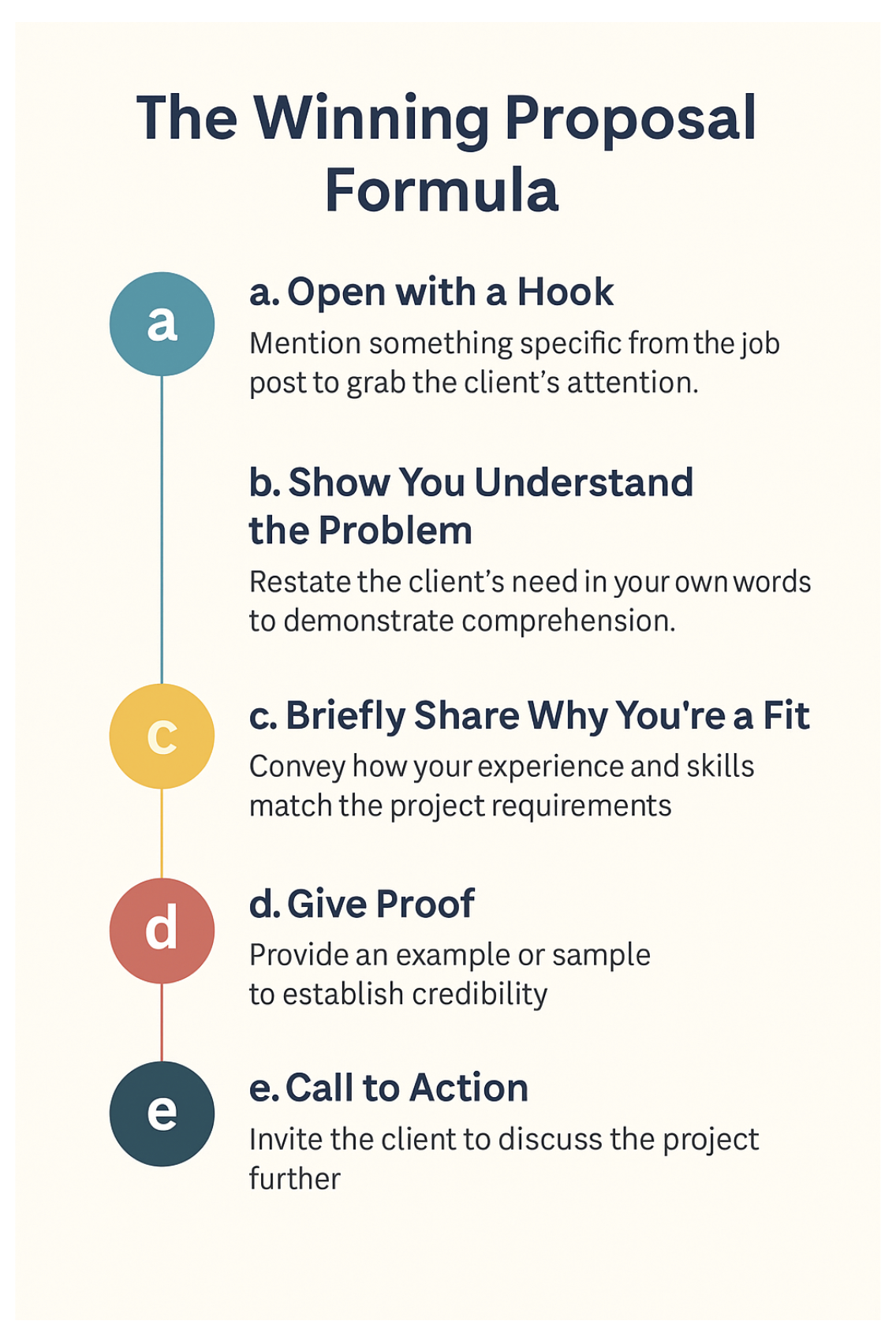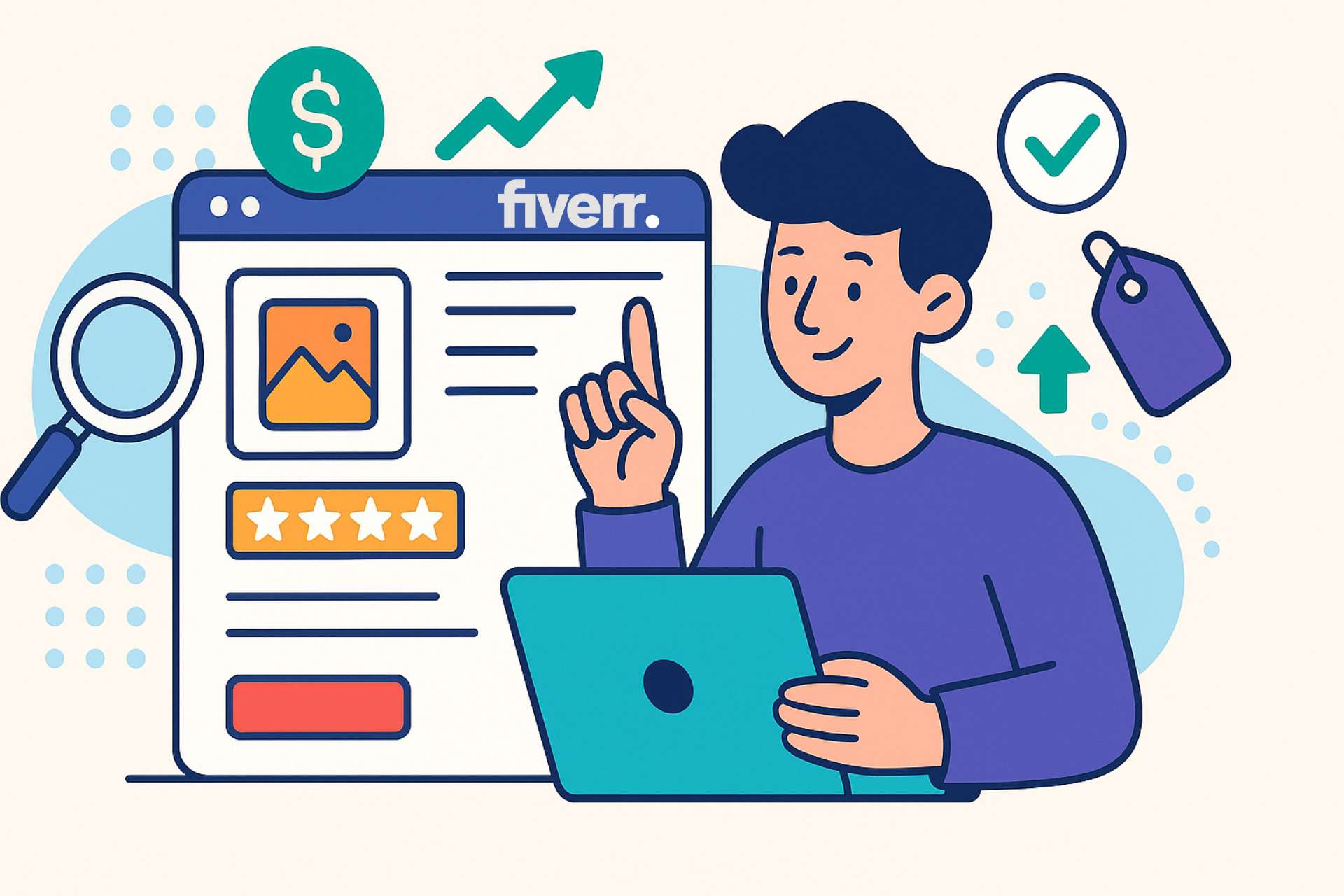Upwork Proposal Secrets: How to Stand Out and Win Projects Fast

How To Write The Best Upwork Proposal
Starting your journey on Upwork can feel exciting… and honestly, a little overwhelming. You’ve probably created your profile, browsed a few job posts, and maybe even hit “Submit a Proposal” once or twice—only to hear crickets. Sound familiar?
Don’t worry, you’re not alone. Every freelancer starts somewhere. The truth is, there are thousands of Filipinos just like you—smart, hardworking, and ready to hustle—trying to land their first few jobs online.
But while the competition is real, here’s something that might surprise you:
You don’t need to be the best. You just need to be the one who connects best.
That’s where your Upwork proposal comes in.
In this post, I’ll share the secrets to writing proposals that actually work—ones that get noticed, get replies, and get you hired faster.
Whether you’re aiming for your first gig or just tired of being ignored, this guide is for you. I’ll even throw in a free template you can customize and start using right away.
Let’s make Upwork less scary—and a lot more rewarding—for you.
Why Most Proposals Get Ignored
Let’s be real… Most proposals on Upwork get zero replies. Not because the freelancers aren’t talented, but because their proposals feel like… robots wrote them.
Here’s what usually goes wrong:
✅ Generic templates.
Clients can smell a copy-paste job from a mile away. If your message looks like it was sent to 20 other people, they won’t even finish reading it.
✅ Too much “me,” not enough “you.”
Many beginners make the mistake of listing their skills and experience like a résumé. But the client doesn’t care (yet). What they do care about is this: “Can you solve my problem?”
✅ Long, boring, formal messages.
Big blocks of text? Nah. Clients skim. If they don’t see something interesting in the first few lines, they’re out.
✅ No proof, no hook, no direction.
If your proposal doesn’t have a clear opening, one strong example, and a confident call to action, it’s easy to ignore.
But here’s the good news:
Don’t worry. If others are doing it wrong, that’s your chance to do it right.
You don’t need to be a writer or marketing expert—just someone who knows how to connect. And I’ll show you how in the next section.
The Winning Proposal Formula
So now that we know what doesn’t work, let’s talk about what does. After reviewing dozens of client feedback, successful freelancers, and real hiring trends on Upwork, I’ve found that a great proposal follows a simple but powerful structure.
This is the exact formula you can follow every time you send a proposal. Keep it short, real, and focused on them—not just you.
a. Open with a Hook (1–2 lines)
Your first sentence is everything. It’s the make-or-break moment where the client decides: “Hmm, I want to read more.”
How? Mention something specific from the job post. This shows you actually read it and you’re not just sending templates.
Example:
“I read that you’re looking for someone to turn your raw podcast recordings into smooth, engaging episodes—and I’d love to help.”
This kind of hook makes the client feel seen. You’re not just another freelancer—you’re someone who gets it.
b. Show You Understand the Problem (2–3 lines)
Clients hire people who understand what they need. So repeat their need back to them—but in your own words.
Example:
“It sounds like you need someone who can clean up audio, add intro/outro music, and deliver ready-to-publish files weekly. I’ve worked with creators who wanted the same thing—clarity, consistency, and peace of mind.”
Now the client feels like, “Wow, this freelancer understands exactly what I need.”
c. Briefly Share Why You’re a Fit (2–3 lines)
Skip the generic “I’m a hardworking individual.” Focus on what you’ve done and how it can help them.
Example:
“I’ve edited 50+ podcast episodes for entrepreneurs and small brands. My goal is to make your voice sound professional and your content shine.”
See that? No need for fancy titles. Just clear, helpful value.
d. Give Proof (2–3 lines)
Even one quick example builds instant trust.
Example:
“Here’s a short clip from a podcast I recently edited: [insert link]. The client loved how I cleaned the audio and made it flow better.”
Don’t have a past client yet? Use a mock sample you created. That still counts!
e. Call to Action (1 line)
Always end with a confident, friendly invitation. No begging, no pressure.
Example:
“Let me know if you’d like to talk more—I’d love to help you with this project.”
Simple. Direct. Positive.

SAMPLE PROPOSAL
Let’s say the client posted:
“Looking for someone to help edit my weekly podcast. I need someone who can remove background noise, trim dead air, and add intro/outro music. Prefer someone detail-oriented and responsive.”
Here’s what your proposal could look like:
Hi [Client Name],
I read that you’re looking for a podcast editor who can help clean up your weekly episodes—and I’d love to support you with that.
You need someone who can handle noise removal, smooth transitions, and consistent quality. I’ve worked with creators who value the same thing: clean audio and fast turnaround.
I’ve edited 50+ episodes using tools like Audacity and Adobe Audition. My focus is on making your content shine while giving you peace of mind.
Here’s a 30-second clip from a past project: [Insert Link]
I also added intro music and removed filler sounds like “uhms” and long pauses.
Let me know if this sounds good to you—I’d be happy to hop on a quick chat.
Best,
[Your Name]
This works for writers, designers, virtual assistants, and more. Just change the content, but follow the same hook → connect → prove → invite formula.
Tips That Make You Instantly Stand Out
Once your proposal follows the winning formula, it’s time to add some small but powerful touches that instantly make you more likable and trustworthy.
Here are a few tips to help you shine, especially as a beginner:
✅ Use the client’s name (if visible).
Starting with “Hi John,” instead of “Dear Sir/Ma’am” adds a personal feel. It shows you’re paying attention, and clients appreciate that.
✅ Customize every proposal.
Never copy-paste. Even if you have a structure you like, tweak it for each job. Mention a line or detail from the job post so it doesn’t feel generic.
✅ Be human.
Talk like a real person. Friendly, helpful, professional—but not stiff. Think “convo with a friend,” not “formal cover letter.”
✅ Keep it short and scannable.
Use white space. Break your message into short paragraphs. Make it easy to read. Clients are busy—they’ll appreciate you getting to the point fast.
✅ Don’t oversell—just connect.
You don’t need to sound like a superhero. You just need to sound like the right partner. Show them you care about their project, not just landing the job.
Pro tip: “Think of it like talking to a friend who’s hiring you. Be kind, confident, and helpful.”
When you show up with clarity, warmth, and focus, you’ll stand out—even in a sea of freelancers.
What to Avoid Like the Plague
If you want your proposals to actually get read—and replied to—there are some common mistakes you need to steer clear of. These might seem small, but they can instantly get your proposal sent to the trash folder.
🚫 Copy-paste proposals
Clients can tell if you’re just recycling the same message. If it doesn’t mention anything specific from their post, they’ll assume you didn’t care enough to read it. And if you don’t care, why should they?
🚫 Buzzwords with no meaning
Avoid lines like “I am a hard-working, passionate individual.” Everyone says that. Instead, talk about how you can help, what you’ve done, or what result you can bring.
🚫 Arrogance or begging
Confidence is good, but don’t come off as mayabang. On the flip side, don’t beg either (“Please hire me, I really need this job”). Stay respectful, helpful, and balanced.
🚫 Proposals longer than the job post
If your proposal is 10 paragraphs long but the job post is only 3 lines, that’s a red flag. Clients want solutions, not essays.
Remember: you don’t need to say a lot—you just need to say the right things. Keep it real, simple, and value-packed.
Bonus: How to Increase Your Chances Even More
Writing great proposals is just one piece of the puzzle. If you want to boost your chances of actually landing the job, here are a few bonus moves that can make a big difference:
Apply fast—within 1 to 2 hours of posting
Clients often get flooded with proposals. If you’re one of the first 5 to apply, your chances of being seen and contacted go up big time. Set alerts or check Upwork regularly, especially during peak hours.
Improve your profile
Even if your proposal is great, the client will check your profile. Make sure your photo is friendly, your title is clear, and your overview speaks directly to your ideal client’s needs.
Add a portfolio link
If you’re just starting out and don’t have projects on Upwork yet, no problem! Upload samples to Google Drive, Canva, Notion, or any easy-to-access link. Show them what you can do, even if it’s just a mock-up or passion project.
Get testimonials from past clients (even outside Upwork)
Did you help a friend with a logo? Edit a video for a local business? Ask for a short testimonial and include it in your profile or proposal. Social proof builds trust—even if it’s not from Upwork yet.
These small steps can give you a huge edge, especially when paired with a strong proposal. Keep showing up, improving, and applying—you’re getting closer to that “You’re hired!” message.
Final Encouragement
If you’ve sent a few proposals and haven’t heard back yet, don’t give up. That’s completely normal. Even the most successful freelancers on Upwork started with a few silent rejections.
Remember, Upwork is a numbers game, but not just about quantity. Yes, you need to apply consistently, but what matters more is the quality of your proposals. Are you connecting with the client? Are you showing real value? Are you making it easy for them to say yes?
Keep learning. Keep tweaking. Each proposal you write is practice, and every practice gets you closer to your first win.
And here’s the truth that should fire you up:
“You don’t need 100 jobs. You just need your first client to believe in you. And that starts with one great proposal.”
Try It and Let Me Know!
Ready to land that first client? Start by using the sample proposal template I shared above—customize it, send it, and see what happens!
If you get a reply (or even just a “Seen” from the client), let me know in the comments. I’d love to cheer you on and hear your progress.





